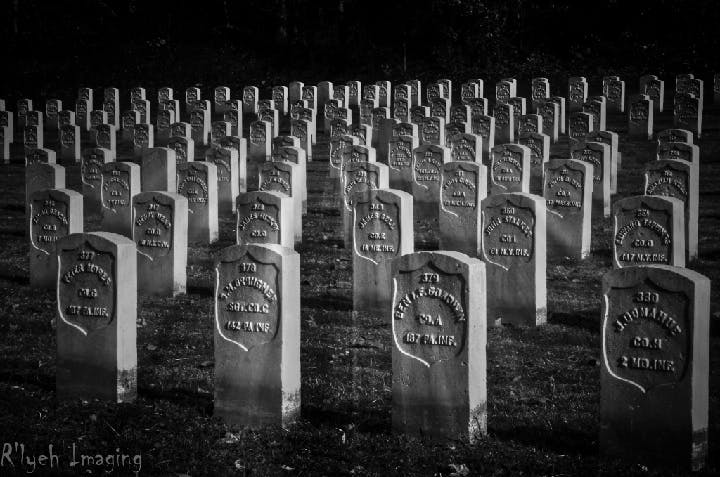Winter 2008
The Mortal Nation
– Robert Wilson
In a new book on the American Civil War, reviewer Robert Wilson finds it was “the shared suffering” of the North and South that “finally made the nation one again.”
After my brother was killed in 1969 in the Vietnam War, I spent a decade having dreams that it was not really true. My family knew that no mistake had been made, but because the Air Force jet in which he had crashed was loaded with bombs, nothing was said, at least to me, about what was in his casket. The absence of a visible corpse, added to the general ravages of grief, produced irrational hopes, some of which I nursed while waking as well as asleep.
Imagine then, as Drew Gilpin Faust invites us to do in this valuable study, the bewildering intensity of sorrow the families of so many Civil War casualties must have felt. Even after the Confederacy’s surrender at Appomattox, Faust writes, “Many soldiers lay unburied, their bones littering battlefields across the South; still more had been hastily interred where they fell, far from family and home; hundreds of thousands remained unidentified, their losses unaccounted for.”
One reason for this appalling situation was the unprecedented number of soldiers killed on both sides, by more efficient weapons as well as infection and disease. Neither government was prepared to handle so many casualties. The task of burying the dead often fell to the victorious army, which controlled the battlefield, but which could barely be bothered to take care of its own casualties, much less the enemy’s. Shockingly little official accounting of the dead was done immediately after a battle. Faust points out that neither government felt a responsibility to provide the families of the missing or dead any definitive information. So the bereaved often took on this burden, traveling to battlefields and hospitals in search of news. Some relatives of the missing kept looking for them for the rest of their own lives.
This Republic of Suffering approaches Civil War deaths first from the viewpoint of the soldiers themselves, who did the dying and the killing, and who saw death around them on an unimaginable scale. But just as in Mothers of Invention (1996), her award-winning history of Southern women’s experience of the war, Faust’s focus is on the emotional effects of the war on those back home, not only during the war but in the decades after. The Civil War worked innumerable changes in individual lives, evoking fervent patriotism and religiosity in some and profound skepticism in others—including such writers as Emily Dickinson, Herman Melville, and Ambrose Bierce, each of whom helped usher in a modern form of consciousness that called into question the possibility of certainty.
The search for meaning that uncertainty created expressed itself in two seemingly opposite ways. One was a heightened sensitivity to the individual death. The idea of the Good Death, one in which the soldier died calmly speaking of his family, country, and creator, was ritualistically reported to families of the fallen by fellow soldiers, commanders, clergymen, or surgeons. But when so many soldiers died anonymously, “identified only, as Walt Whitman put it, ‘by the significant word Unknown,’” the need increased throughout the war for the governments to ensure that the names and bodies were preserved in an orderly way. “The strongest impetus for these changes,” Faust writes, “was the anguish of wives, parents, siblings, and children who found undocumented, unconfirmed, and unrecognized loss intolerable.”
The second result of the search for meaning was “the emerging notion of the Civil War dead as a describable and shared national loss that transcended individual bereavements.” The dead on both sides had a collective importance that gave the war a heightened meaning and ennobled the impulses that had led to it. This idea, and the widespread local tendency after the war to desecrate the graves of the enemy, led to the creation of vast national cemeteries where isolated gravestones and bodies spread across the countryside could be gathered, tended, and protected. This process of reburial continued for many years, as did attempts to identify the unknown dead and to compile lists of those who had served. These efforts, supported by Congress and the War Department, “involved a dramatically new understanding of the relationship of the citizen and the state,” affirming the importance of individuals as the “lifeblood” of the nation, Faust writes.
Faust, the president of Harvard and a distinguished scholar, builds her book by accretion rather than through narration. If it is sometimes repetitive and schematic, it is also comprehensive and persuasive. She directs her attention always to the South as well as the North, as befits her thesis that the shared suffering of the two finally made the nation one again.
* * *
REVIEWED: This Republic of Suffering: Death and the American Civil War. By Drew Gilpin Faust. Knopf. 346 pp.
Cover photo courtesy of Flickr/R'lyeh Imagining
